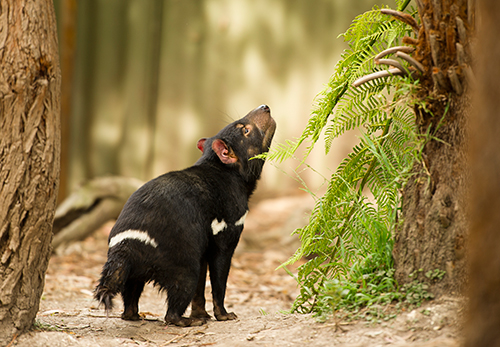![Tasmanian devils are evolving resistance in response to a highly lethal and contagious form of cancer. [ross1248/GettyImages]](https://genengnews.com/wp-content/uploads/2018/08/Aug31_2016_Getty_499697054_TasmanianDevil9027158154-1.jpg)
Tasmanian devils are evolving resistance in response to a highly lethal and contagious form of cancer. [ross1248/GettyImages]
When the name Tasmanian devil pops up in the news, most of our minds wander to the tan, wildly whirling animated creature with the insatiable appetite, from the cartoons of our youth. Except for the mouthful of sharp teeth, Warner Bros. didn’t do the best of jobs accurately depicting the rare marsupial (it was a cartoon after all)—especially when it came to the highly lethal and contagious form of cancer that threatens the species.
Now, an international team of researchers led by scientists at Washington State University (WSU) has uncovered that the Tasmanian marsupials are evolving at an incredibly rapid rate in response to the spread of devil facial tumor disease (DFTD)—which was first discovered in 1996 and has a nearly 100% mortality rate. The research team found that two regions in the devils' genomes are promptly changing in response to the cancer, with many animals developing genetic resistance to DFTD. The investigators are hopeful that their genomic discoveries will support future medical research exploring how animals evolve rapidly in response to cancer and other pathogens.
“Our study suggests hope for the survival of the Tasmanian devil in the face of this devastating disease,” explained senior study author Andrew Storfer, Ph.D., associate professor of biology at WSU. “Ultimately, it may also help direct future research addressing important questions about the evolution of cancer transmissibility and what causes remission and reoccurrence in cancer and other diseases.”
Tasmanian devils are the largest carnivorous marsupials in the world and an integral part of Australia's natural heritage. Devils display significant aggression toward one another, which often involves biting on the face. This sometimes transmits DFTD, one of only three known forms of transmissible cancer and by far the most deadly.
In the 20 years since its discovery, DFTD has wiped out an estimated 80% of devils in Tasmania—the only place in the world where the animals live. By way of comparison, canine transmissible venereal tumor, a sexually transmitted form of cancer that only affects dogs, has been around for at least 11,000 years and is generally not fatal to domesticated animals.
In contrast to many of the current models that predicted extinction, populations of Tasmanian devils at long-diseased sites persist. In light of this, the researchers wanted to investigate whether there was a genetic component to some of the devils' survival.
“If a disease comes in and knocks out 90% of the individuals, you might predict the 10% who survive are somehow genetically different,” noted study co-author Paul Hohenlohe, Ph.D., assistant professor of biology at the University of Idaho. “What we were looking for were the parts of the genome that show that difference.”
The researchers mined a vast trove of devil DNA collected and stored before and after the outbreak of DFTD by scientists at the University of Tasmania. The frequency of genes in specific regions of the old DNA was compared to the frequency of genes in corresponding regions of DNA collected following DFTD emergence at three sites in Tasmania.
“We report rare genomic evidence of a rapid, parallel evolutionary response to strong selection imposed by a wildlife disease,” the authors wrote. “We identified two genomic regions that contain genes related to immune function or cancer risk in humans that exhibit concordant signatures of selection across three populations. DFTD spreads between hosts by suppressing and evading the immune system, and our results suggest that hosts are evolving immune-modulated resistance that could aid in species persistence in the face of this devastating disease.”
The findings from this study were published recently in Nature Communications in an article entitled “Rapid Evolutionary Response to a Transmissible Cancer in Tasmanian Devils.”
The research team is in the process of determining the specific functionality of the genomic regions identified in the study. They are optimistic that disease-free devils with the apparently DFTD-resistant DNA can be bred to enhance the genetic diversity of an off-island captive insurance population in case devil reintroductions are needed in the future.


